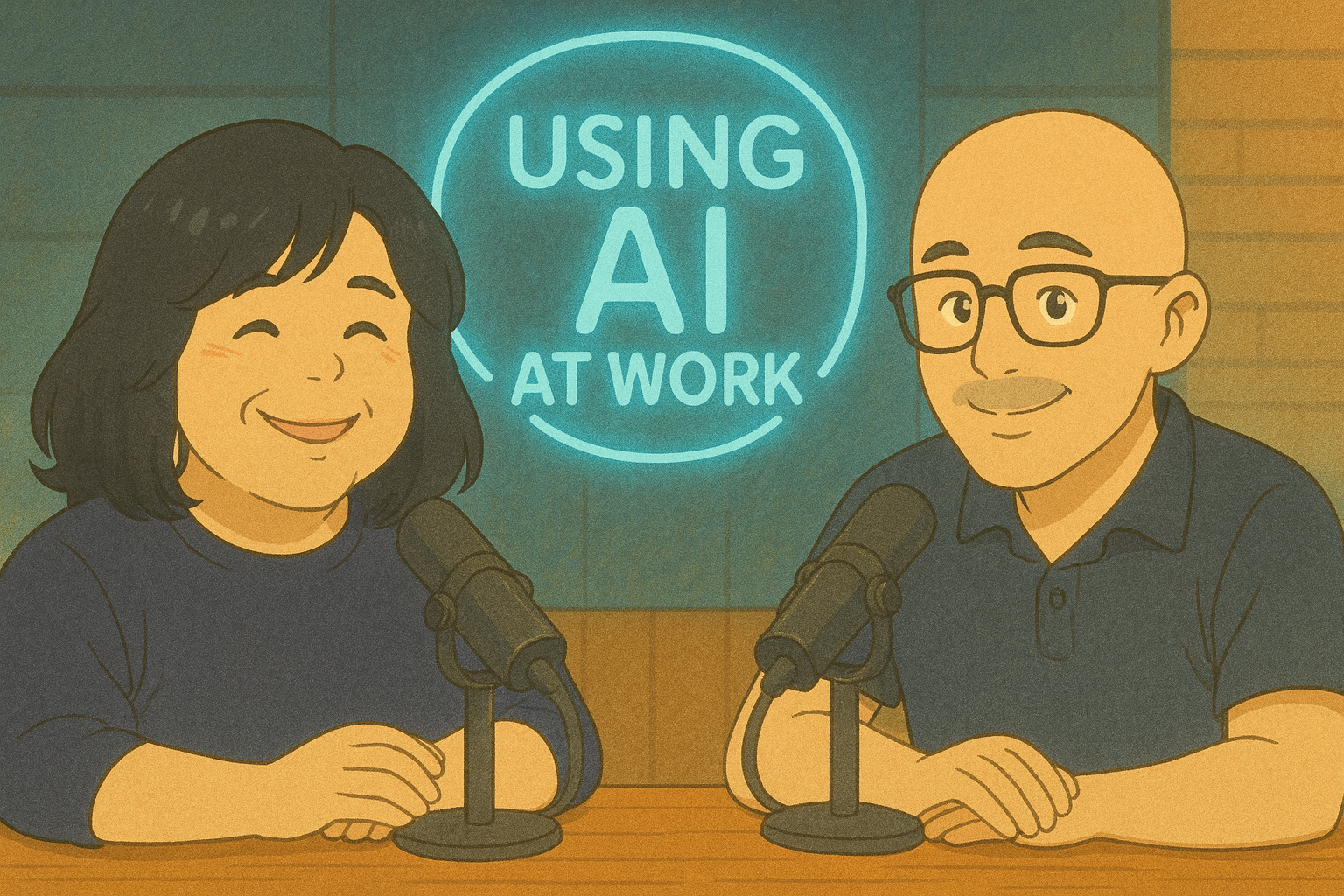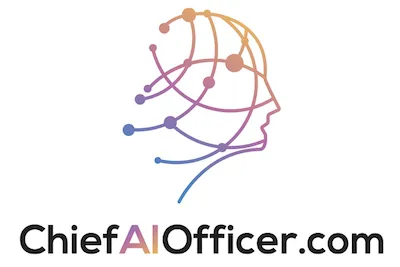From Fear to Strategic Implementation: A Chief AI Officer’s Roadmap for SMBs
The latest episode of Using AI at Work features Maria Elena Duron, Chief AI Officer and marketing expert, discussing how small and medium-sized businesses can successfully implement AI while managing the human side of technological transformation. Host Chris Daigle explores the critical balance between technical capability and change management that determines whether AI initiatives succeed or fail.
The Hidden AI Usage Problem
Before organizations can properly implement AI governance, they must confront an uncomfortable reality: employees are already using AI tools, often without permission or oversight. Duron reveals a pattern she consistently discovers during initial assessments, when leadership asks employees what AI tools they’re using, most claim they’re following company guidelines. However, verification interviews tell a different story.
In one memorable case, a CEO believed the entire team was using ChatGPT Teams for business purposes. During Duron’s verification process, employees admitted they were actually using personal accounts outside the corporate environment, exposing proprietary information and personally identifiable data without any security controls.
This shadow AI usage stems from two competing forces: legitimate business needs that AI can address, and organizational paralysis around implementation. IT departments rightly concerned about security often create approval bottlenecks, leading employees to solve problems independently using consumer-grade tools on personal email accounts.
The Change Management Foundation
Duron’s approach begins not with technology selection but with addressing the fundamental human concern: “Am I being replaced?” This fear exists across all organizational levels, from front-line staff to IT leadership worried about their relevance in an AI-augmented environment.
Her positioning framework reframes AI implementation as an investment in people rather than a replacement strategy. When meeting with teams, she explicitly states: “Your leadership has made an active decision to invest in training you rather than replacing you. That’s why I’m here.”
This psychological foundation proves essential for the change management journey ahead. Without addressing fear and uncertainty upfront, even the most sophisticated AI implementation will face passive resistance or active sabotage from employees who see the initiative as an existential threat.
The Structured Implementation Process
Duron’s methodology follows a disciplined timeline designed to build confidence while delivering measurable results:
Week 1-2: Discovery Phase Individual interviews with team members across all departments, including conversations with external vendors who provide services like SEO or HR support. These discussions explore current AI experience, personal and professional vision for AI usage, and how individual strengths can support the company’s brand promise.
A critical component involves assessing where team members fall on the fear-to-enthusiasm spectrum. Identifying champions who genuinely embrace AI innovation helps establish internal advocates who can influence peers more effectively than external consultants.
Week 2-3: Verification and Leadership Alignment A second round of interviews verifies initial findings and uncovers the actual tech stack being used, including shadow IT tools. This data gets compiled into comprehensive leadership presentations that outline gaps, opportunities, and realistic priorities.
During this phase, Duron works closely with finance teams to understand baseline metrics. If leadership wants to see a 66% increase in specific outcomes, she needs to verify current measurement systems and confirm the target’s feasibility given available resources and timelines.
Week 3-4: Roadmap Development The discovery culminates in a detailed roadmap report covering 30-day, 90-day, and 180-day implementation phases. This document establishes governance policies, including AI usage guidelines and tool policies that protect proprietary information and personally identifiable data.
Critically, the roadmap limits initial implementation to three or four high-impact initiatives. This constraint prevents team overwhelm while creating opportunities to test communication patterns and identify organizational bottlenecks.
The AI Council Structure
Rather than centralizing AI ownership in IT departments, Duron advocates for cross-functional AI councils comprising two to three key stakeholders. The ideal council includes the most enthusiastic champion (regardless of department), someone with operational business knowledge, and representation from IT to address security concerns.
This structure acknowledges that effective AI implementation requires understanding business processes, not just technical architecture. Marketing directors, operations heads, or finance leaders often make excellent council members because they understand workflow pain points and can articulate measurable success criteria.
The council’s primary responsibility involves governance, establishing guardrails around AI usage while enabling experimentation within safe boundaries. This includes mandating use of enterprise tools like ChatGPT Teams rather than personal accounts, defining what information can be shared with AI systems, and creating processes for evaluating new tools.
Starting with Executive Productivity
When asked where to begin AI implementation with minimal risk and maximum impact, Duron consistently recommends starting with executive productivity improvements. The recurring theme across organizations of all sizes: “I wish there were another me.”
By analyzing the CEO’s daily routine, she identifies administrative tasks consuming strategic thinking time. Initial AI implementations might automate meeting preparation, email triage, or document drafting, activities that free up 8-10 hours weekly for high-value leadership activities.
This approach delivers multiple strategic benefits. First, executives experience AI value firsthand, building conviction for broader implementation. Second, early wins at the leadership level create organizational momentum and budget support for expansion. Third, solving executive pain points demonstrates the consultant’s understanding of business impact versus technical novelty.
The Role Copilot Concept
One powerful implementation pattern involves creating “role copilots”, custom AI systems trained on specific individuals’ expertise that others can access. Duron uses this approach in her own business, creating a custom GPT trained on 400 YouTube videos capturing her communication style and expertise.
Her virtual assistants use this tool to draft community responses that sound authentically like Duron, then add their human layer of judgment before posting. The AI provides the foundation, appropriate tone, relevant information, and stylistic consistency, while humans contribute context-aware decision-making and relationship management.
For businesses, role copilots might capture a senior sales leader’s objection-handling strategies, a customer service director’s de-escalation techniques, or a technical expert’s troubleshooting methodology. This approach scales expertise across teams while preserving the human judgment that AI cannot replicate.
Leveraging Notebook LM for Knowledge Management
Duron strongly advocates for Google’s Notebook LM as a business intelligence tool, particularly given its integration with existing Google Workspace ecosystems. The platform allows teams to create project-specific knowledge bases incorporating documents, transcripts, presentations, and other content.
Key capabilities include:
- Audio overviews that summarize complex materials
- Video overviews for visual learners
- Automatic FAQ generation from source materials
- Mind mapping for conceptual relationships
- Study guide creation for training purposes
The critical insight is using Notebook LM as an organizational memory system. Rather than searching through email threads or folder structures to find specific information, teams can query their knowledge base conversationally and receive contextual responses with source citations.
For executives spending 22% of their workday searching for information (according to recent research), this capability represents significant productivity recovery without requiring technical expertise or complex integrations.
Measuring Success: Efficiency, Productivity, and Effectiveness
Duron distinguishes between three levels of AI impact that organizations must understand when setting expectations:
Efficiency: Completing the same task in less time (four hours reduced to 30 minutes)
Productivity: Completing more tasks in the same timeframe (two tasks per hour increased to five)
Effectiveness: Combining efficiency and productivity to create measurable business impact
Most organizations initially focus on efficiency wins, the visible time savings that build team confidence in AI tools. However, true ROI emerges when efficiency gains translate to productivity increases, allowing teams to expand output without proportional headcount growth.
Leadership must understand that effectiveness, the ultimate goal, typically requires 90-180 days to materialize. Search engines need time to index improved content, customers need exposure to enhanced service touchpoints, and teams need practice integrating AI into unconscious competence.
Managing Unrealistic Expectations
The most common unrealistic expectation Duron encounters: “Transform my business in 30 days.” This typically manifests as demands for immediate revenue increases, dramatic efficiency improvements, or instant search visibility gains.
Her response emphasizes that AI implementation is a process, not an event. Even perfectly executed technical implementation requires human adaptation time. Search engines need 90 days to recognize and reward content improvements. Customers need exposure to new service patterns before behavior changes.
The key to managing expectations involves establishing leading indicators that demonstrate progress toward lagging outcome metrics. If the ultimate goal is increased average order value, early indicators might include improved product page engagement, enhanced search visibility, or more effective email personalization.
The Marketing Professional’s Advantage
Duron observes that marketing professionals, particularly those with social media management experience, adapt to AI consulting roles more easily than many technical specialists. The reason: they’re accustomed to measuring and explaining intangible outcomes.
How do you prove brand awareness increased? How do you attribute social media activity to business outcomes? These familiar challenges prepare marketers for the ambiguity inherent in AI impact assessment, where correlation often substitutes for direct causation.
This insight suggests that businesses building AI councils should consider marketing and operations leaders alongside technical staff. The combination of technical capability, business process knowledge, and comfort with ambiguous measurement creates stronger governance than technical expertise alone.
Practical Next Steps for SMBs
For small and medium businesses ready to begin AI implementation:
- Conduct an honest audit of current AI usage, including shadow tools employees use without approval
- Identify your champion – the person most excited about AI possibilities who can influence peers
- Start with executive productivity – demonstrate value at the leadership level first
- Establish basic governance – even a one-page AI usage policy provides essential guardrails
- Limit initial scope – three to four initiatives in 90 days prevents overwhelm
- Set realistic timelines – expect 90-180 days for meaningful business impact
- Invest in your team – frame AI as capability enhancement rather than replacement
The organizations that succeed with AI implementation recognize it as fundamentally a human challenge requiring technical solutions, not a technical challenge requiring human accommodation.
Ready to implement AI strategically in your small business? Listen to the full episode for detailed insights on change management, governance frameworks, and realistic implementation timelines that set organizations up for sustainable success.




